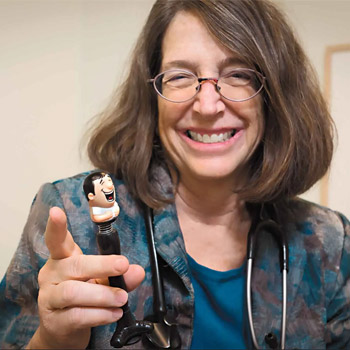Why medicine should be a laughing matter
Laughter offers health benefits and can be creatively incorporated into clinical practice.
Carrie A. Horwitch, MD, MACP, may not be a comedian, but she knows how to leave a crowd in stitches.
Rather than reacting to punchlines, attendees found themselves belly-laughing their way through exercises like “The Hokey Pokey” and an imaginative rollercoaster ride by the end of her session at the American Medical Women's Association's 107th Annual Meeting, held virtually at the end of March.

As a Laughter Leader certified by the World Laughter Tour, Dr. Horwitch is trained to lead therapeutic laughter in groups. Mirthful laughter can be a wellness technique for both health care workers and patients, she said.
“Laughter is the most inexpensive and most effective wonder drug. Laughter is a universal medicine,” Dr. Horwitch said, quoting Nobel Prize-winning writer and mathematician Bertrand Russell.
But laughter and humor are not one and the same. While humor can stimulate laughter, it is personal and subjective and does not always land, she noted.
“I actually rarely use humor at work with patients because … they may not find my comments particularly funny,” said Dr. Horwitch, who is an ACP Well-being Champion and Chair of the College's Patient and Interprofessional Partnership Committee.
Using humor at work can even negatively impact patient care. In her book, “Death of My Uterus and Other Humorous Events: A Collection of Stories, Poems, and Limericks about the Indignities of Cancer,” Dr. Horwitch wrote about her own experience with a male physician whose attempt at humor missed the mark while she was dealing with cancer.
“When I was worried about the hair loss from the chemo, [he] patted his bald head and said, ‘At least yours will grow back,’” she said. “And I chose not to work with that physician as a doctor because of that comment. He did not understand my perception, he did not understand my worries. So I think we have to be careful when we use [humor] in practice.”
But that doesn't mean that humorous internists need to be serious all the time. During her session, Dr. Horwitch reviewed laughter's health benefits and offered creative ways to incorporate it into practice.
Though laughter therapy and research have been around for decades, they aren't often covered by major media outlets, in part because “There's not really a lot of money that's being generated,” she said. “There is no drug, there is no pill.”
Some names of pioneers in the field may sound familiar, though. These include William F. Fry, MD, known as the father of gelotology (the study of laughter and its effects on the body); Indian physician Madan Kataria, MD, who created Laughter Yoga and started the first laughter club in 1995; and Hunter “Patch” Adams, MD, played by Robin Williams in the 1998 film about his life in medical school.
The research shows that laughter reduces cortisol, can ease muscle tension, can reduce renin and angiotensin levels in the setting of diabetes, and has favorable effects on arterial stiffness and immune function, Dr. Horwitch reported. In addition, since laughter is a mix of breathing and exercise, it improves oxidative stress, as well as increases levels of endorphins and enkephalins, she noted.
“This is something that every patient can do and all of us can do for our own health. … It helps with pain, it's exercise (so it burns calories), and best of all, this is absolutely free. You can do this everywhere,” said Dr. Horwitch, who is a clinical associate professor of medicine and associate program director of the internal medicine residency at Virginia Mason Franciscan Health in Seattle.
She uses laughter in her primary care office, and so do her nurses and some of her colleagues. “It's also been seen in cancer centers, nursing homes, schools, police stations, military bases, refugee centers, and businesses,” she said. “There is a group called Clowns Without Borders that specifically tries to go into war-torn areas to try to help with some of that stress.”
Dr. Horwitch first used laughter therapy on a patient with diabetes and depression. “I could not get her A1c below 9, no matter what I tried, no matter what medications,” she said.
Having just become certified as a Laughter Leader, Dr. Horwitch asked the patient if she'd be willing to learn a laughing exercise that could be done at home—even on the couch—to see if it improved her health. When the patient returned to the office a couple of months later, it was clear that the new skill had stuck.
“The first thing she did when I walked into the room was go, ‘Hahahahahahaha’ and laugh, and her A1c was a full point lower, and she had started walking and exercising and did very well,” Dr. Horwitch said. “In fact, her A1c is now below 7.5.”
Lately, she said she's been advising patients to stop listening to and watching the news or negative content in favor of watching more comedic content to help reduce stress.
A study of 17 healthy adults, published in 2010 by the American Journal of Cardiology, found that ischemia-induced brachial artery flow-mediated vasodilation (assessed by B-mode ultrasound imaging) increased by 17% after participants watched a comedy and decreased by 15% after watching a documentary. Carotid arterial compliance (assessed by ultrasound imaging and applanation tonometry) increased by 10% after watching the comedy but did not significantly change after watching the documentary.
“So always better to watch something that's funny. Stop watching or listening to the news, which is just distressing us,” Dr. Horwitch said. “If you want to know about it, read it. Don't listen to it.”
In addition to laughter, the World Laughter Tour also teaches exercises for good-hearted living, which can serve as a reminder to try to make each workday better for all, she noted. “They have the five days of the week, each day for a different encounter.”
Mondays are for compliments—a reminder to say “thank you” to colleagues. “I'm trying to practice that every day: thanking my [medical assistants], thanking my front desk staff, thanking my nurses for showing up every day for my patients,” Dr. Horwitch said. “And it is one of the biggest things, when we asked our staff what helps them want to stay in their jobs, it was actually feeling appreciated.”
Tuesdays are for flexibility. “That means we do need to be flexible with the times, as I think we have learned very well in the past few years,” she said.
Wednesdays are for gratitude. “Remember to keep your eye on the whole donut, not just on the hole,” Dr. Horwitch said.
Thursdays are for kindness toward others. “I've been watching ‘Ted Lasso,’ who I think epitomizes kindness in everything he does as a coach,” she said.
Finally, Fridays are for forgiveness. “Please remember that our anger makes us stay angry, but the other people have moved on from that,” Dr. Horwitch said. “And then the weekends, of course, are for chocolate or for some other pleasures that we enjoy.”



